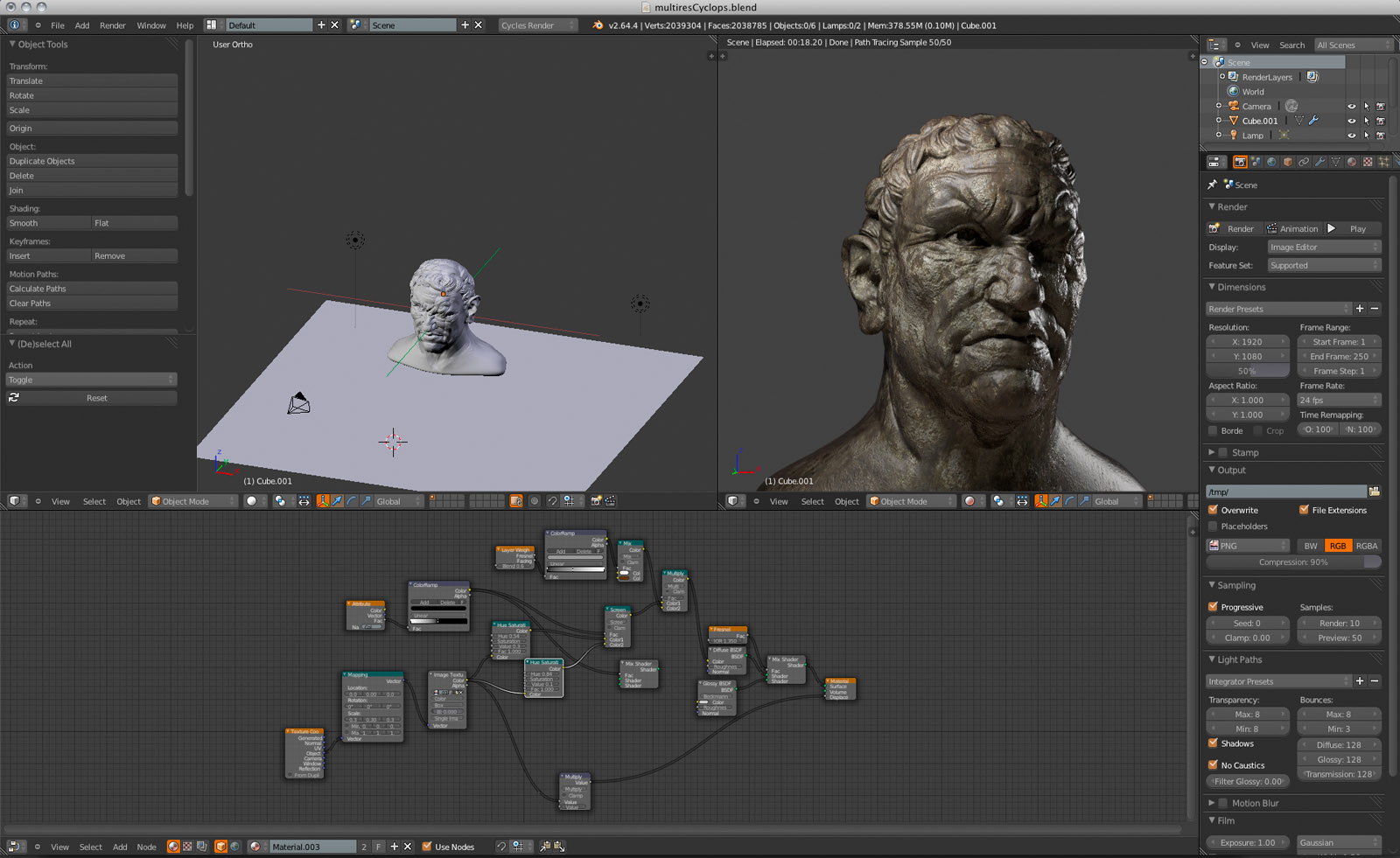New blender sculpting is coming soon.
-
Hi Michalis,
I appologize if I have been unpleasant. It appears that your knowledge about art and art history is far lot more than I can personally pretend
 . So that you are the best positioned to help yourself by yourself.
. So that you are the best positioned to help yourself by yourself.
Your search is involving us (Peter and I), that's the reason why
In fact, I had thought to suggest you this reading since I have read myself this great man that have been Viollet-Le-Duc. If mine is little, his knowledge was incredibly vast and the scope of his work has revolutionized the history of art and architecture approach. But above all, he was a free thinker.
That's why I'm not ashamed to offer you this reading.@unknownuser said:
Si l’on considère qu’Eugène Viollet-le-Duc occupa la première chaire où figuraient explicitement les mots « histoire de l’art », il fut, en France, un des fondateurs de cette discipline. En se basant sur ces mêmes critères institutionnels, il faut toutefois constater que sa carrière de « professeur d’histoire de l’art et d’esthétique » fut remarquablement brève, limitée à sept leçons par le chahut de son auditoire.
with my sympathy,
Simon
-
Simon, I started reading Eugène-Emmanuel Viollet-le-Duc.
It will take me some time and it seems very interesting.
Thank you.It's the language barrier again.
I just meant that I found a kind of a key hidden in these excellent byzantine art of ~1300.
Such frescos that are described as caricatures in these Kenney Mencher's videos.
Their draperies, the portraits, all these are wrong in front of his eyes, wrong anatomy, etc.
He possibly don't understand. Actually, he doesn't understand why we use color in painting, how to organize it. How to organize the light, to capture it on a sculpt. How to draw exactly what we need and nothing more.
But when he comes to modern art, suddenly remembers all these. Good for him, it's never too late.

-
@unknownuser said:
Simon, I started reading Eugène-Emmanuel Viollet-le-Duc.
It will take me some time and it seems very interesting.
Thank you.Thank you to test this reading

As it is written in a manner of demonstrations, I'm afraid that it is difficult to read it in diagonal reading.
I hope you will send me a comment if this book attracts you enough to read more than few sheets.@unknownuser said:
(about Kenney Mencher) But when he comes to modern art, suddenly remembers all these. Good for him, it's never too late.
Demonstration that an angry man can be at the same time a kind man

++Simon.
-
I was wondering about your opinion and I got it. I wanted to understand your comments on the approach in ancient Greek sculpture better. I don't think that Kenney Menchner thinks these things are "wrong" but a different way of approaching art. I think he does demonstrate that Renaissance art tended for more of what we call realistic depiction today, while developing from Byzantine and Classic forms. Certainly there have been different ways from the beginning of time and all related too.
-
Well, I watched most of the videos of Menchner. IMO he says something wrong in every few sentences, especially when he comes into technical details. In fresco particularly. As he knows a little in byzantine art, as most western people, he also doesn't know that you can keep fresco workable for three days. So, in byzantine art, we don't see seams around a figure. He called it secco, but this isn't true. I learned how to achieve this. Fresco is a wonderful medium, the best. It's like painting in watercolor and oil, the same time. Unfortunately, it remains on a wall LOL.
But I liked the part on roman sculpting. It's the first time in the history of art that we see real portraits. Not only sculpting but painting as well (fayum portraits) (OK these last are more greek than roman but we usually call them grecoroman). -
I couldn't find any better, but this video has some interesting information.
http://www.youtube.com/watch?v=MLCW0zKR4xk&feature=related
It seems that they hadn't any autocad or sketchup app, but they were clever and very experienced. -
Cool TV movie

Drawing the curvature of the columns with the shadow's sun was a task !
Else the rest is very Easy!

Minute 0.47 -
@Pilou
I have some questions on what we see in the Parthenon restoration video.
It's well known that Parthenon doesn't use golden ratio only.
As for the curvature, the "entasis"(=tension) of the columns, they didn't use the sun of course. The idea came from this, maybe, but not the method. The geometrical solution propose on this video is questionable also. It's not an arc then, it's a part of an ellipse. Or the opposite. They had to draw an ellipse. I wander what method they used.Fibonacci Gauge doesn't mean golden ratio only. Neither golden ratio is The key to beauty or something.
1,2,3,5,8,13,21... -
@unknownuser said:
They had to draw an ellipse. I wander what method they used.
May be this one: a rope two nails a pencil.

-
Yes all is suppositions!
I was two years ago at the Parthenon

The blend of new and old stones was very curious, "It's no earthly use"
(in French like "applying a cautery to a wooden leg"
the white new marble and the old stones were something unreal
And the crowd mob of turists an another curiosity

Ps about the explanation, the French Subtitles of youtube System were some weird!

-
@gilles
This is one of the few methods. Try to be precise in large scale with this method. I'm not sure. They needed precision.
@Pilou.
Aged and new marble together. Not that bad. What other options? To leave them on the ground? To make new marble looking old?
Something you may not know. The new marble looks fatter in this video. It is, then comes the fine tuning. Only when all the column is builded up. The same method as in ancient masonry. In fact, there aren't any modern methods. You can see today the weights they were using on their machines. The same you can find on today's elevators. Sometimes, it's so easy to say "they used slaves for the job". As saying, today, there aren't any slaves. -
Maybe it will more speedy and practical to remake a new one in an another place as a new forum and leave the old stones in place?
-
These old stones are a lot. It's the whole parthenon down in pieces.
What you saw in this video was an extreme example. Most pieces are 80% there.
More speedy to to rebuild a new parthenon? Where? There is only one place to do this.
Parthenon fits in the hill of acropolis, nowhere else. You have to watch the lines of the Attic hills around, and see what relation they have with the lines of Parthenon. This isn't a roman building. It's close or even better to the wonderful Egyptian architecture. Scale! We had to wait for seeing such beauty till 20th century architectural masterpieces. The great ones I mean. Still not even close to Parthenon. It's a kind of magic.Jean Corteau visited acropolis, joined by his greek friend and artist Iannis Tsarouhis.
"what a perversity, he said, greeks made their temples looking like cages with all these columns around"
The answer from Iannis Tsarouhis was "exactly, this is all about, greeks turned their perversity into virtue"
Corteau never forgot this answer. -
SO GREAT...YOU ARE MASTER

-
Thank you PHUONG_HEHE.
Not a master though.
Another one. One eye man.
-
Wonderful work and rendering! I wonder what the process and interface is like working on something like this. Any videos showing WIP?
-
Thanks.
No videos, I don't feel comfortable when video capturing is running.
Here's a screengrab.

-
Cool cyclope

The nodes' system is always a little bit anti artistic!
(lttle electric trains
-
I do not agree.
This node system is very artistic Pilou.
It's a kind of magic. It's the easiest and the more spontaneous UI I had so far.
A two pages presentation-tutorial is all you need. Everything else is simple logic. Possibilities are endless.
As you plug all these nodes, you have a real time progressive preview running. A dream came true.It looks complicated.
But what you really see is a combination of simple shaders and some Pshop-like controllers. It isn't a post pros though. But you may start thinking like it. This coloramp for instance controls a B&W map used as value (works like the levels in Ps) . A value to control how two images are mixing together. So, if I have one texture node, split it in two hue-staturation nodes, make one green and the other red. Then, use a dirt vertexpainting node to control (plug it as factor, we can have greener texture as cavity.
It's a way to combine lot of shaders. It's quite easy after learning the basics. -
I can't see the image Michalis.
Merry Christmas to you too.



Advertisement







